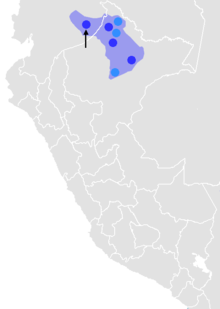Záparo language
Záparo is a nearly extinct language spoken by the Sápara or Záparo people of Ecuador. As of 2000, it was spoken by only one person out of a total population of 170 in Pastaza Province, between the Curaray River and Bobonaza Rivers. Záparo is also known as Zápara and Kayapwe. The members of the Záparo ethnic group now speak Quichua, though there is a language revival effort beginning. Záparo is sometimes confused with Andoa, though the two languages are distinct. Záparo has a subject–verb–object word order.
| Záparo | |
|---|---|
| Native to | Peru, Ecuador |
| Ethnicity | 200 Záparo (2007)[1] |
Native speakers | 5 (2007)[1] |
Zaparoan
| |
| Language codes | |
| ISO 639-3 | zro |
| Glottolog | zapa1253[2] |
 | |
History
The Zaparos were one of the most numerous peoples of western Amazonia, and it is thought the language was spoken by more than 100,000 people at some point. The number of speakers steadily declined after the arrival of Europeans under the effect of old world diseases and wars with other Amazonian people driven off by the progress of European settlement.
At the beginning of the 20th century, Zaparos fell victims to the rubber boom. As with many Amazonian peoples, they were virtually enslaved and used as cheap labor to collect rubber. As a result, their communities were heavily disrupted, and their scattered members began to intermarry with neighboring tribes. The use of the Záparo language was progressively discontinued in favor of Quechua.
Only 150–170 ethnic Zaparos remain today, most of them in the Loreto Canton, and all of them are Quechua speakers. Very few people have some command of Zaparo, and those are elderly and isolated. The language is no longer used in everyday conversations, even though a language revival is currently underway.
Brenda J. Bowser, a professor of anthropology at CSUF, is working to capture the linguistic and oral history of the Záparo of Ecuadorian Amazonia with the help of a grant by the National Science Foundation. She hopes to fill a large gap in the understanding of the precolonial social and cultural history of the upper Amazon.[3]
Phonology
Zaparo phonology is relatively simple, with only four vowels and 15 consonants. Consonant clusters are disallowed, except when they involve [ʔ].[4]
| Bilabial | Dental | Postalveolar | Velar | Glottal | |
|---|---|---|---|---|---|
| Stop | p | t t͡s |
t͡ʃ | k kw~kʷ |
ʔ |
| Fricative | s | ʃ | h | ||
| Nasal | m | n | |||
| Approximant | w~β | j | |||
| Flap | ɾ |
| Front | Central | Back | |
|---|---|---|---|
| Close | i | ɨ | u~o |
| Open | a~æ |
Bibliography
- Moya, R. (2009). Pana sápara atupama, Nuestra lengua sápara: Diccionario trilingüe Sápara-Castellano-Quichua (Colección Runakay, Diccionario Escolar Intercultural Bilingüe de las Lenguas Ancestrales, 1.). Ecuador: Ministerio de Educación.
- Peeke, Catherine M.. 1991. Bosquejo Gramatical del Zaparo, Cuadernos Etnolingüisticos, n°14, Quito: Instituto Lingüistico de Verano,
- Peeke, Catherine. 1962. "Structural Summary of Zaparo," in SEIL I, 125–216.
References
- Záparo at Ethnologue (18th ed., 2015)
- Hammarström, Harald; Forkel, Robert; Haspelmath, Martin, eds. (2017). "Zaparo". Glottolog 3.0. Jena, Germany: Max Planck Institute for the Science of Human History.
- "Capturing a Dying Language: Professor Documents Linguistic and Oral History of Záparo". Retrieved January 3, 2012.
- http://www.native-languages.org/zaparo_guide.htm
External links
- (in English) Zaparo's lost secret
- (in Spanish) Zaparoan grammar
- (in Spanish) Revitalizando el idioma zápara
- (in French) SAUVONS... LA LANGUE ZAPARA !